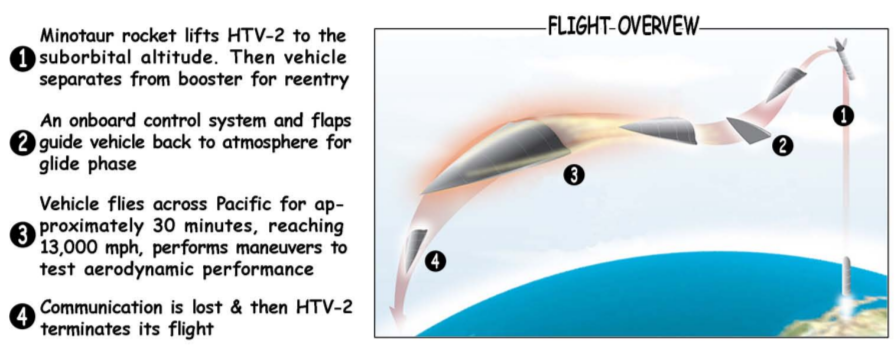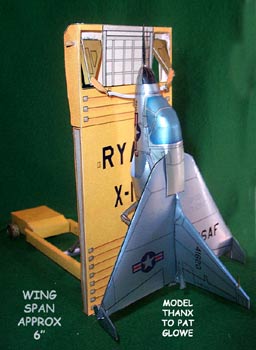




Darpa HTV-2
DARPA HTV-2
 Rare color photo of the DARPA HTV-2 over North America on the approach to the Pacific ocean. Photo courtesy of Vlad at Fiddlersgreen.net
Rare color photo of the DARPA HTV-2 over North America on the approach to the Pacific ocean. Photo courtesy of Vlad at Fiddlersgreen.netFollowing the somewhat successful flight of the fastest thing you've ever seen (unless you've seen a meteor up close), DARPA (the Defense Advanced Research Agency) failed to reveal that a paper model commemorating the event was being developed at the Skunkworks of Fiddlersgreen in (almost) complete secrecy. At hypersonic speed this paper model can theoretically fly faster than the eye can see. At 13,000 mile per hour, it is estimated that the HTV-2 would take only 12 minutes to fly from New York City to Los Angeles. In the reverse direction, from Los Angeles to New York, the paper version has traveled much faster in testing, traversing the distance in mere milliseconds via the internet.
DARPA's Falcon Project, (which stands for Force Application and Launch from CONtinental United States) has been a joint venture between DARPA and The USAF (United States Air Force) and it is believed that no actual falcons were harmed in the development of this technology. Researchers have known that a fully mature falcon will typically fly at very high speeds and can easily change his direction because his wings are tapered and thin, so that same design concept was utilized to form the sleek lines of this high speed aircraft, even though it may not be able to change directions quite as easily as a real falcon. A more important goal for now is to get it to fly straight without burning up or flying apart and to be maneuverable at speeds approaching Mach 20. This has proven to be an exceedingly difficult objective.
More about DARPA
Maiden Voyage
In the first flight of the HTV-2 (Hypersonic Technology Vehicle) launched 22 April 2010, the vehicle actually reached speeds of Mach 22 exactly three days after it was determined that it would fly in three days. At least three more days after that, a much more advanced version of the HTV-2 constructed entirely out of paper card stock took all the attention away from the carbon composite version while the team in the FG Skunkworks worked at hypersonic speeds to get this model into the hands of the public. Although initially designed to compete with DARPA's version, the paper version of the aircraft was so radically different that it was eventually released to the aviation industry long before many people had even heard of it. Despite completely burning up in the atmosphere during routine testing, the FG version went into full production in the late part of July 2015 when it was determined that it possessed certain characteristics that were considered superior to DARPA's version. For instance, the Total Imaginary Cargo in Kilograms for Low-orbit Experiments (the TICKLE factor) was clearly at play in the decision.
Unofficially, the HTV-2 was not really competing with either the FG HTV-2 FALCON or the FG Hawk but a certain amount of rivalry was detected when select personnel were overheard saying, "I want one." This was not at first taken seriously, but the very same personnel were eventually put in charge of the project.
Weaponry
Considering the shortage of on-board crew needed to operate weaponry, the selection of weapons to be used on the Falcon HTV-2 has remained in question and, for the most part, has not been publicly disclosed by the Department of Defense Conventional Prompt Global Strike programs. Once it has been determined that such a vehicle can safely arrive at any place on the globe in less than an hour, it will probably be outfitted with a payload appropriate for the mission. Small leaflets printed with free tickets to Grateful Dead concerts have been suggested.
It has also been suggested that the vehicle itself could be used as a weapon if it could be accurately guided to intercept with something you want to crash into, perhaps small weddings attended by undesirable dignitaries or political opponents. "High value" or "Fleeting" targets are intended to be attacked and ultimately destroyed. For now, DARPA would be satisfied just to hit a small rabbit or a goat, so all high value livestock are advised to remain indoors.
GPS Guidance and Tracking
Because it was able to maintain a GPS (Global Positioning Satellite )signal while traveling at a rate of 3.6 miles per second, weaponry designed to shoot down a Falcon HTV-2 was determined to be much easier to design than originally believed. In the event that two Falcons ever were to become engaged in a dogfight, this data would prove to be invaluable to ground crews. DARPA has not been highly concerned with enemies gaining control of the weapon due to the fact that they have not been able to control it very well themselves.

Second Test Flight
DARPA provides a link to information regarding the phases of the second flight to those who have obtained special authorization but special access has not yet been granted to those who hold Magic Keys subscriptions. This flight was scheduled for August 2011
Public Disclosure about the Falcon Project
Some of the information regarding many aspects of this technology, including the re-entry plan and some flight objectives, has not actually been considered secret. Some details have been released because it clearly would have the ability to deliver a nuclear payload long before before a regular ICBM can be prepared and launched. This is a possible future offensive/defensive weapon which could compete with the nuclear submarine, but for now it is being used for research on space orbit entry.
The world is being shown that unmanned drone projects such as this may be more advanced than previously believed. Releasing this information may have a deterrent effect on any possible aggressor. Conversely, any failures regarding such an objective might have the exact opposite effect. Much of the previously available material on the project is no longer available
What we Know about the HTV-2
Chris Schulz, the HTV-2 program manager for DARPA, made this statement: "We know how to boost the aircraft to near space. We know how to insert the aircraft into atmospheric hypersonic flight. We do not yet know how to achieve the desired control during the aerodynamic phase of flight. It's vexing; I'm confident there is a solution. We have to find it."
Other Uses...
Possible applications include rapidly deployed surveillance platforms and long range package delivery for troops in the field.
The heat generated by friction against the air is thought to be high enough to cause the entire aircraft to melt. In simulations for melted blobs it has already been shown that small brush fires can be ignited from large distances using molten space junk. Consequently, important considerations for the use of this technology to conduct controlled burnings for the purposes of forestry conservation have not yet been addressed. Nevertheless, other uses have been debated.
Scott Fyn from the Fiddlersgreen development team has recently been quoted as saying "Deliberately crash-landing these vehicles into the ocean has demonstrated one method we can employ to reduce the quantity of space junk that eventually ends up in orbit.
| Brian Weeden From the Secure World Foundation conducts research on space debris has been quoted as saying "Put simply, the notion is that if you have an area that is shared by everybody, that is common to everybody, and the classic example is a grazing area for a farm or a village, where everyone grazes their animals in one area but nobody owns it, you can run into a situation where it is in everyone's own selfish interest to use it to their own advantage." You can listen to more about space debris in this podcast... Swirling graveyard of space junk or read his essay about the 2011 U.S. Space strategy to become a bit more aggressive in space. |

|
Flight Overview

|

|

|
HTV-2 module separating from Minotaur Rocket

|
Artistic rendition of HTV-2 burning up after re-entry
(another great model by Vlad)

Assembly details from the instruction sheet, which comes with the download.
Information about the Falcon Project
What People Say
Wow, that's fast!
Other American X-Planes from Fiddlersgreen

Bell X-1 Manned Rocket |

Ryan X-13 Vertijet (VTOL) |

North American X-15 Manned Rocket |


